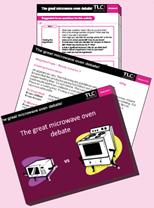 |
Learners consider the most energy and cost efficient method of cooking food. They research an ‘energy audit’ to test the hypothesis that electrical kitchen items are the most energy demanding and therefore the most expensive items to run in the home. From this, learners predict and justify if the use of a microwave oven is more efficient than a conventional oven. Learners plan a strategy for carrying out suitable calculations as evidence, extracting and using relevant data. They communicate their numerical reasoning, including how and why they have used their chosen data and the calculation strategies developed. They review the outcomes in light of the calculations made, justifying their conclusions. Learners reflect on the initial problem of saving money by reviewing energy usage in the kitchen and make an informed decision about the extent that this may be possible and likely savings to be gained. |
It is recommended that the activity is run collaboratively in pairs or small groups. However, calculations could be individually made and outcomes compared when discussing learners’ opinions and the conclusions they draw.
Science and Technology
Being curious and searching for answers is essential to understanding and predicting phenomena.
Forces and energy provide a foundation for understanding our universe.
Mathematics and Numeracy
The number system is used to represent and compare relationships between numbers and quantities.
Geometry focuses on relationships involving shape, space and position, and measurement focuses on quantifying phenomena in the physical world.
Statistics represent data, probability models chance, and both support informed inferences and decisions.
LNF - Listening, Reading, Speaking, Writing; Mathematical Proficiency, Number system, Measurement, Statistics.
Creativity and innovation; Critical thinking and problem solving; Personal effectiveness; Planning and organising.
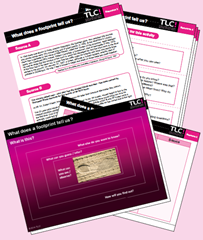 |
Learners are initially invited to interrogate an image of a footprint in the sand. The questions posed develop learners’ skills in the areas of observation, literacy, critical and creative thinking. They are expected to formulate ‘good’ questions which will lead them into thinking about the use of footprints in forensic science and carrying out research into their use. Findings are gathered through researching their own questions and answers, which are recorded on a QuADS grid. Learners move onto evaluating and reviewing sources relating to ‘giants’ from the past, and some more up-to-date data on heights, in order to try and work out a ratio between foot length and height. Through their calculations they are expected to explain their numerical reasoning. This ratio was first suggested by Paul Topinard (1830-1911) in the mid-1800s, in order to estimate a person’s height from a foot print (foot length:stature ratio). He determined this ratio to be 15% or expressed another way, a person’s maximum foot length divided by 0.15 reveals their height. |
Science and Technology
Being curious and searching for answers is essential to understanding and predicting phenomena.
Computation is the foundation for our digital world.
Humanities
Enquiry, exploration and investigation inspire curiosity about the world, its past, present and future.
Events and human experiences are complex, and are perceived, interpreted and represented in different ways.
Mathematics and Numeracy
The number system is used to represent and compare relationships between numbers and quantities.
Algebra uses symbol systems to express the structure of mathematical relationships.
Statistics represent data, probability models chance, and both support informed inferences and decisions.
LNF - Listening, Reading, Speaking, Writing; Proficiency, Number system, Algebra, Measurement, Statistics.
DCF - Producing.
Creativity and innovation; Critical thinking and problem solving; Personal effectiveness; Planning and organising.
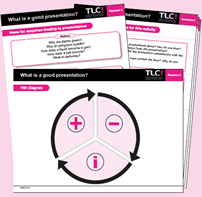 |
Learners watch a video clip of children presenting findings from an enquiry entitled ‘What is this?’. They identify the positive, negative and interesting points about the presentation. Learners use these observations and their prior learning to develop success criteria for ‘What makes a good presentation?’. Learners create their own presentation and review their success criteria as an on-going process, justifying their reasoning. They are peer assessed as they make their presentations and through focused reflection, learners refine their criteria for future use. |
Science and Technology
Being curious and searching for answers is essential to understanding and predicting phenomena.
Design thinking and engineering offer technical and creative ways to meet society’s needs and wants.
The world around us is full of living things which depend on each other for survival.
Matter and the way it behaves defines our universe and shapes our lives.
Forces and energy provide a foundation for understanding our universe.
Humanities
Enquiry, exploration and investigation inspire curiosity about the world, its past, present and future.
Events and human experiences are complex, and are perceived, interpreted and represented in different ways.
Our natural world is diverse and dynamic, influenced by processes and human actions.
Human societies are complex and diverse, and shaped by human actions and beliefs.
Informed, self-aware citizens engage with the challenges and opportunities that face humanity, and are able to take considered and ethical action.
Health and Well-being
Developing physical health and well-being has lifelong benefits.
How we process and respond to our experiences affects our mental health and emotional well-being.
Our decision-making impacts on the quality of our lives and the lives of others.
Healthy relationships are fundamental to our well-being.
LNF - Listening, Reading, Speaking, Writing.
DCF - Producing.
Creativity and innovation; Critical thinking and problem solving; Personal effectiveness; Planning and organising.
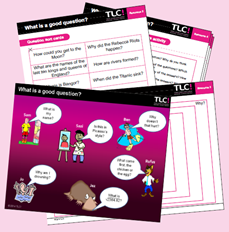 |
Learners develop success criteria for quality questions and use a series of short tasks to activate their prior understanding and build on it. They are posed challenging questions that ensure their success criteria and the justification for them is as high level as possible. Having developed and refined their success criteria, learners evaluate other groups’ criteria before making final amendments to their own success criteria for using in the future. |
This activity has been written to improve learners’ generic questioning skills and therefore can fit into any area or any combination of areas of learning and experience.
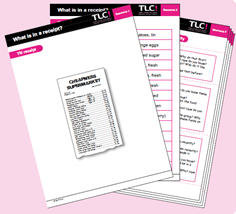 |
Learners review a supermarket receipt in terms of food groups and types, and develop their numeracy skills through some simple calculations. Following research about recipes, learners create a menu for a ‘healthy meal’ and use it to work out the items and the quantities of each required. Learners research relevant prices and use their findings to draw conclusions about the healthiest and cheapest two course meal for six people. Their menu, and the reasoning behind choosing it, is communicated to the rest of the class through a poster or leaflet. If at all possible, learners should be allowed to make their meal, as they will find this whole activity more rewarding and therefore be better engaged. Throughout the activity, learners work in pairs. |
Science and Technology
Being curious and searching for answers is essential to understanding and predicting phenomena.
Health and Well-being
Developing physical health and well-being has lifelong benefits.
Mathematics and Numeracy
The number system is used to represent and compare relationships between numbers and quantities.
Geometry focuses on relationships involving shape, space and position, and measurement focuses on quantifying phenomena in the physical world.
LNF - Listening, Reading, Speaking, Writing; Mathematical Proficiency, Number system, Geometry and Measurement.
DCF - Producing.
Creativity and innovation; Critical thinking and problem solving; Personal effectiveness; Planning and organising.
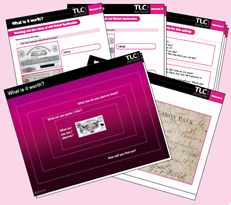 |
Learners use a source square to interrogate an image of a historical Welsh banknote and formulate quality questions using their observations. They research these questions, draw conclusions and calculate the current value of old banknotes, before designing their own modern day Welsh banknote. |
Humanities
Enquiry, exploration and investigation inspire curiosity about the world, its past, present and future.
Events and human experiences are complex, and are perceived, interpreted and represented in different ways.
Expressive arts
Responding and reflecting, both as artist and audience, is a fundamental part of learning in the expressive arts.
Creating combines skills and knowledge, drawing on the senses, inspiration and imagination.
LNF - Listening, Reading, Speaking, Writing; Mathematical Proficiency, Number system.
DCF - Producing, Data and computational thinking.
Creativity and innovation; Critical thinking and problem solving; Personal effectiveness; Planning and organising.
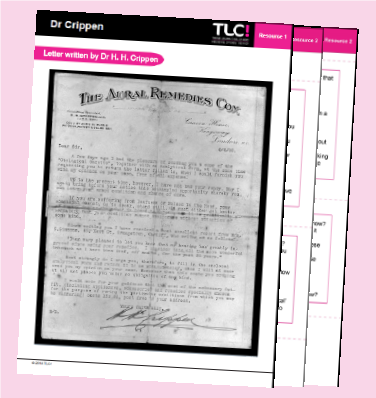 |
Learners gather ideas and information about Dr Crippen from older family and friends and share their findings. They also consider how much of their own prior knowledge and understanding about the world originates through family stories and being told information by their elders. Learners read and consider the contents of a letter sent by Dr Crippen to a potential patient and use maps to explore the addresses contained in it. They plan and carry out research about Dr Crippen to find out about the crime he was convicted of, the evidence against him and his sentence and eventual fate. Learners use their plan and findings to present a two minute summing up case for either the |
Science and Technology
Being curious and searching for answers is essential to understanding and predicting phenomena.
The world around us is full of living things which depend on each other for survival.
Humanities
Enquiry, exploration and investigation inspire curiosity about the world, its past, present and future.
Events and human experiences are complex, and are perceived, interpreted and represented in different ways.
Languages, literacy and communication
Languages connect us.
Understanding languages is key to understanding the world around us.
Expressing ourselves through languages is key to communication.
LNF - Listening, Reading, Speaking, Writing; Mathematical Proficiency, Number system.
Creativity and innovation; Critical thinking and problem solving; Personal effectiveness; Planning and organising.